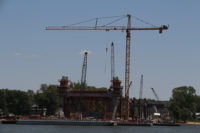October Construction Falls 14 Percent Nationwide
The value of new construction starts retreated 14% in October to a seasonally adjusted annual rate of $434.9 billion, according to McGraw-Hill Construction, a division of The McGraw-Hill Cos. Much of the decline was due to a sharp pullback by the electric power and gas plant category after a robust September.
If this volatile project type is excluded from the month-to-month comparisons, total construction starts in October would register a 3% gain. Greater activity was reported in October for the public works sector while both nonresidential building and housing settled back. Through the first 10 months of 2012, total construction starts on an unadjusted basis came in at $390.4 billion, a 4% gain relative to the same period a year ago.
The October statistics brought the Dodge Index to 92 (2000=100), down from the 107 reported for September. Over the first 10 months of 2012, the Dodge Index has fluctuated within the range of 85 to 116, averaging 97 during this period.
“This year’s pattern for total construction has been shaped to some degree by the swings for the electric utility and gas plant category, which is still on track to achieve a new annual high in current dollar terms, even with its weak October performance,” said Robert A. Murray, vice president of economic affairs for McGraw-Hill Construction. “Leaving out electric utilities and gas plants, the amount of construction starts in 2012 would be up 3% through the first 10 months, which reflects a mixed pattern by project type.
‘For housing, the emerging recovery for single-family housing is joining the strengthening trend for multifamily housing that’s already under way. For nonresidential building, commercial building is seeing modest growth in 2012, but this has been offset by declines for institutional building and manufacturing plant construction. Public works year-to-date has been basically flat, beginning to stabilize after its 14% downturn in 2011. While the pattern of overall construction activity does seem to be moving towards more broad-based expansion, the persistent uncertainty affecting the U.S. economy continues to pose a downside risk. The degree to which policymakers in Washington DC are able to agree on the steps necessary to avert the fiscal cliff will determine whether the nascent upturn for construction continues to grow in 2013 or slides back,” Murray said.
Nonbuilding Construction
Nonbuilding construction in October dropped 32% to $133.4 billion (annual rate), retreating after the previous month’s 68% jump. September had been lifted by a 335% surge for the electric utility and gas plant category, as a $4.8-billion liquefied natural gas plant (the Sabine Pass Liquefaction Project) was included as a September start, along with six powerplant and transmission line projects valued each in excess of $100 million. For October, the largest electric utility and gas plant project was $88 million for transmission line work in Massachusetts, leading to a 93% decline for the category.
In contrast, the public works sector in October climbed 19%. The miscellaneous public works category, which includes such diverse project types as sitework, mass transit, and pipelines, soared 52% in October. The boost to miscellaneous public works came from $2 billion related to work on the Keystone Pipeline Gulf Coast Expansion, located in Oklahoma and Texas.
Highway construction in October advanced 23%, aided by $900 million for work on the I-95 HOV/HOT Lanes project in Virginia.
The large increase marked a departure from what has been a declining trend in 2012 for highway construction, which on a year-to-date basis was still down 11%. Bridge construction in October retreated 7%, although the month did include $94 million for bridge reconstruction work in Ohio. The environmental public works categories were led by a 41% increase for river/harbor development, which reflected the start of $331-million explosives handling wharf in the state of Washington. The other environmental categories, sewers and water supply systems, dropped a respective 16% and 5% in October.
Nonresidential Building




